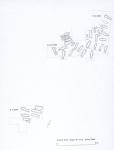Summary (English)
From October 13 to November 21, 2005, the second excavation season took place at the Svećurje – Radun in Kaštel Stari, above the church of St. George of Radun, where the medieval cemetery is placed. It was a continuation of rescue excavations from 2004.
The excavation goal was to define the cemetery area as much as possible (26 graves were excavated in two trenches, S-1 and S-2, in 2004), therefore the research was focused on the outer space of the site, north of the church of St. George, where Trench 3 (S-3) was installed on an area of over 100 m2, connected to S-2 and extends all the way to the north-western corner of the site. Further distribution of the graves towards the west and south in relation to S-2 is confirmed. This year, 20 graves were discovered, 18 of which have been fully excavated, and two were just visible in the profiles towards the west and south. On the entire surface, the culture layer was shallow (0-40/50 cm) and ends at the natural soil layer.
The typology and arrangement of graves, the way and number of burials in individual graves are basically the same. The total number of graves placed here until the end of burial at the beginning of the Early Modern Age (16th century) remains unknown. The newly discovered graves have the same layout and grave structures as those excavated in 2004. They were placed in one layer in several irregular rows. Grave constructions are made by stone slabs placed vertically around the coffin, and the stone slab lid. Since they were placed on a very shallow level, a good part of them suffered more or less damaged. There were no grave goods in most of the graves. Only in one grave (G-42) were found a belt buckle and a ring, which can be typologically classified in the late Middle Ages (14th/15th century). The number of burials in individual graves also indicates the period of the late Middle Ages. These are mostly graves with multiple burials over a long period, and in situ skeletons’ arms were often found crossed on the chest. Close parallels for the typology of finds and burial structures exist in the medieval cemetery of Sućurac around the church of St. George of Putalje, a few kilometres from Radun. The cemetery of Putalj contains graves laid in 2-3 layers, a consequence of the narrowness of the space; the cemetery in Radun occupies a significantly larger area, so there was no need for layering and the graves are lined up in linear rows in one layer. Although we already have some knowledge about the cemetery around St. George of Radun, the final conclusion will only be possible after the excavation of all the graves in that location has been completed (Tonči Burić 2006, Hrvatski arheološki godišnjak 2/2005, 408–409).
- Tonči Burić
Director
- Tonči Burić
Team
Research Body
- Muzej grada Kaštela
- Muzej hrvatskih arheoloških spomenika
Funding Body
- Hrvatske autoceste d.o.o.






![Download [PDF]](/excavation/skins/fasti/images/results/download_sml.png)